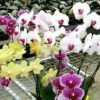# The Development of the Phalaenopsis Orchid Industry Worldwide
 The Phalaenopsis orchid, commonly known as the moth orchid, has become one of the most popular and commercially successful orchid species globally. With its stunning blooms, wide range of colors, and long-lasting flowers, Phalaenopsis orchids have transcended their origins in Southeast Asia to establish a significant presence in the global floral market. This article explores the development of the Phalaenopsis orchid industry outside its native habitat, examining its historical growth, current trends, and future prospects.
The Phalaenopsis orchid, commonly known as the moth orchid, has become one of the most popular and commercially successful orchid species globally. With its stunning blooms, wide range of colors, and long-lasting flowers, Phalaenopsis orchids have transcended their origins in Southeast Asia to establish a significant presence in the global floral market. This article explores the development of the Phalaenopsis orchid industry outside its native habitat, examining its historical growth, current trends, and future prospects.
## 1. Historical Background of Phalaenopsis Orchids
### 1.1 Origins and Early Cultivation
Phalaenopsis orchids are native to tropical regions of Southeast Asia, including the Philippines, Taiwan, and Indonesia. Their captivating beauty was recognized by early orchid enthusiasts and collectors, particularly in the 19th century when European botanical exploration introduced these flowers to Western horticulturists.
The first successful cultivation of Phalaenopsis orchids in Europe occurred in the mid-1800s, marking the beginning of their journey from exotic wildflowers to popular ornamental plants. Initial breeding efforts focused on enhancing the flower’s size, color, and longevity, leading to the establishment of hybrid varieties that would captivate growers and consumers alike.
### 1.2 The Rise of Hybridization
The 20th century saw significant advancements in orchid hybridization, with Phalaenopsis orchids at the forefront of this movement. Breeders began to experiment with crossing different species and hybrids to create new and diverse flower forms. The introduction of advanced breeding techniques, such as tissue culture, enabled growers to produce large quantities of high-quality orchids more efficiently.
As a result, the 1980s marked a turning point in the Phalaenopsis orchid industry, with hybrids gaining immense popularity in the floral market. Their resilience, ease of care, and stunning visual appeal made them a favorite among consumers and decorators, further propelling the industry’s growth.
—
## 2. The Global Expansion of the Phalaenopsis Orchid Industry
### 2.1 Key Regions of Production
As the demand for Phalaenopsis orchids surged, several regions worldwide emerged as key players in the industry. Notable regions include:
– **The Netherlands**: Often referred to as the “orchid capital of the world,” the Netherlands has become a leading exporter of Phalaenopsis orchids. Dutch growers leverage advanced greenhouse technology and horticultural practices to cultivate orchids year-round, ensuring a consistent supply to international markets.
– **Taiwan**: With a long history of orchid cultivation, Taiwan is renowned for its Phalaenopsis hybrids. The country has invested heavily in research and development, leading to the creation of unique varieties that are sought after globally. Taiwanese growers also participate actively in international flower exhibitions and competitions, showcasing their innovations.
– **Thailand**: Thailand has emerged as a major player in the Phalaenopsis orchid market, focusing on both cultivation and export. The country’s favorable climate and rich biodiversity support the growth of various orchid species, making it a hub for orchid breeding and trade.
– **United States**: In the U.S., Florida and California are primary regions for Phalaenopsis cultivation. American growers have embraced the trend of indoor gardening, driving the demand for these orchids as houseplants. Local nurseries and garden centers have expanded their offerings, contributing to the industry’s growth.
### 2.2 Export Dynamics
The global trade of Phalaenopsis orchids has become a multi-billion-dollar industry, with various countries exporting these flowers to markets around the world. Major importers include the United States, Japan, and several European countries, where the demand for orchids continues to grow.
Export dynamics have shifted over the years, with an increased focus on sustainable practices. Growers are adopting eco-friendly cultivation techniques and packaging methods to meet consumer preferences for environmentally responsible products. As a result, the orchid industry is working towards achieving sustainability certifications and adhering to international standards.
—
## 3. Factors Contributing to Industry Growth
### 3.1 Consumer Preferences and Trends
The growing popularity of Phalaenopsis orchids can be attributed to several factors:
– **Aesthetics**: The striking appearance of Phalaenopsis orchids appeals to consumers looking to enhance their living spaces with beautiful flowers. Their diverse colors and forms allow for creative arrangements and decorative displays.
– **Ease of Care**: Compared to other flowering plants, Phalaenopsis orchids are relatively low-maintenance, making them suitable for both novice and experienced gardeners. Their resilience and ability to thrive in various environments contribute to their appeal.
– **Indoor Gardening Movement**: The rise of the indoor gardening trend has significantly boosted the demand for houseplants, including orchids. Consumers are increasingly seeking ways to bring nature into their homes, driving sales of Phalaenopsis orchids.
### 3.2 Advances in Cultivation Techniques
The development of modern cultivation techniques has played a crucial role in the growth of the Phalaenopsis orchid industry. Key advancements include:
– **Tissue Culture**: Tissue culture has revolutionized orchid propagation, allowing growers to produce large numbers of uniform plants quickly. This method not only increases efficiency but also ensures the health and quality of the orchids.
– **Greenhouse Technology**: The use of advanced greenhouse systems, such as automated climate control and hydroponics, enables year-round production of orchids. Growers can optimize conditions for growth, resulting in higher yields and improved flower quality.
– **Integrated Pest Management**: Sustainable pest management practices have been adopted by many growers to minimize the use of chemicals while maintaining plant health. These methods promote a more environmentally friendly approach to orchid cultivation.
### 3.3 Global Marketing Strategies
Effective marketing strategies have been instrumental in promoting Phalaenopsis orchids worldwide. Growers and distributors leverage various channels, including:
– **Social Media**: The rise of social media platforms has allowed growers to reach a broader audience, showcasing their products through engaging content. Instagram and Pinterest, in particular, are popular platforms for sharing stunning orchid photography and care tips.
– **Flower Shows and Exhibitions**: Participation in international flower shows and exhibitions provides growers with opportunities to showcase their orchids, network with industry professionals, and attract potential buyers. These events highlight the beauty and diversity of Phalaenopsis orchids.
– **E-commerce**: The growth of e-commerce has transformed the way consumers purchase orchids. Online retailers offer a wide selection of Phalaenopsis orchids, making it easier for customers to find and order their desired varieties.
—
## 4. Challenges Facing the Phalaenopsis Orchid Industry
### 4.1 Environmental Concerns
As the orchid industry continues to grow, environmental concerns have come to the forefront. Key issues include:
– **Deforestation**: The demand for orchids has led to habitat loss in some regions, raising concerns about sustainability. Efforts to promote sustainable harvesting and cultivation practices are crucial to protect natural ecosystems.
– **Climate Change**: Climate change poses a threat to orchid cultivation, with changing weather patterns affecting growth conditions. Growers must adapt to these changes by implementing more resilient cultivation practices.
### 4.2 Market Competition
The Phalaenopsis orchid market is becoming increasingly competitive, with numerous growers vying for market share. To stay ahead, businesses must focus on product differentiation, quality, and innovation.
### 4.3 Supply Chain Challenges
The global supply chain for orchids can be complex, involving multiple stakeholders from growers to retailers. Disruptions in transportation, trade policies, and market fluctuations can impact the availability and pricing of Phalaenopsis orchids.
—
## 5. Future Prospects for the Phalaenopsis Orchid Industry
### 5.1 Innovations in Breeding
The future of the Phalaenopsis orchid industry will likely see continued innovations in breeding. Growers are exploring genetic modification and biotechnological advancements to create new varieties with unique colors, patterns, and fragrances. These innovations will enhance the attractiveness of Phalaenopsis orchids and meet evolving consumer preferences.
### 5.2 Sustainability Initiatives
As environmental awareness grows, sustainability initiatives will play a crucial role in shaping the future of the Phalaenopsis orchid industry. Growers will increasingly adopt eco-friendly practices, such as organic cultivation, water conservation, and waste reduction, to align with consumer demands for sustainable products.
### 5.3 Expanding Global Markets
Emerging markets in Asia, Latin America, and Africa present new opportunities for the Phalaenopsis orchid industry. As disposable incomes rise and urbanization increases, the demand for ornamental plants, including orchids, is expected to grow in these regions.
### 5.4 Education and Awareness Programs
Increasing consumer education and awareness about orchid care and cultivation will further drive the popularity of Phalaenopsis orchids. Workshops, online courses, and community events can help enthusiasts develop their gardening skills and deepen their appreciation for these beautiful flowers.
—
## Conclusion
The Phalaenopsis orchid industry has experienced remarkable growth and transformation over the years, evolving from a niche market to a global powerhouse in the floral industry. With its stunning beauty, ease of care, and versatility, the Phalaenopsis orchid has captured the hearts of consumers worldwide. As the industry continues to innovate and adapt to changing market dynamics, it holds promising prospects for the future. By embracing sustainability, advancing cultivation techniques, and expanding into new markets, the Phalaenopsis orchid industry is poised for continued success in the years to come.
—

